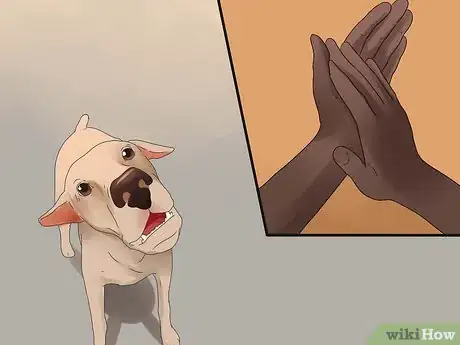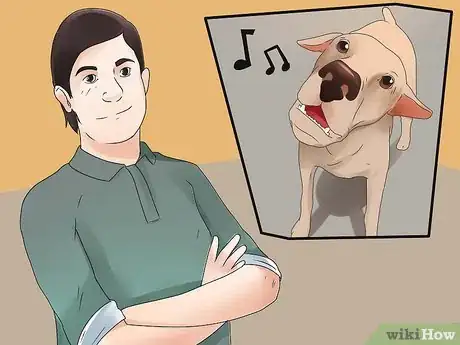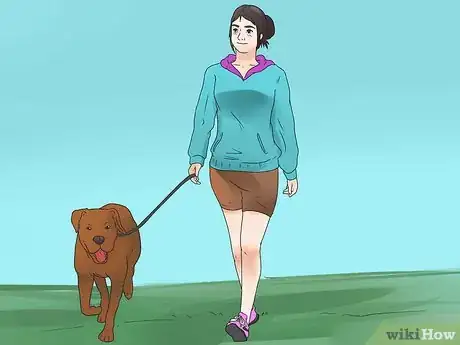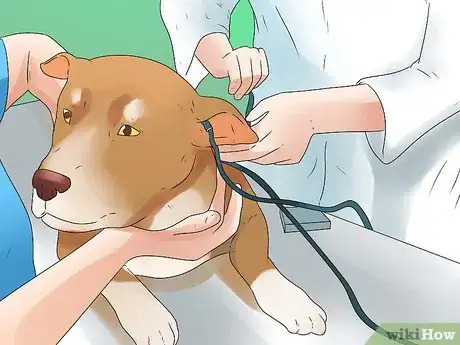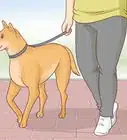This article was co-authored by Pippa Elliott, MRCVS. Dr. Elliott, BVMS, MRCVS is a veterinarian with over 30 years of experience in veterinary surgery and companion animal practice. She graduated from the University of Glasgow in 1987 with a degree in veterinary medicine and surgery. She has worked at the same animal clinic in her hometown for over 20 years.
wikiHow marks an article as reader-approved once it receives enough positive feedback. This article received 13 testimonials and 88% of readers who voted found it helpful, earning it our reader-approved status.
This article has been viewed 172,111 times.
Deafness is a common problem, especially in elderly animals, but it can also occur as a congenital problem that affects puppies. It’s important to know if your dog is deaf because it affects his safety. A deaf dog that does not hear an approaching car may get into a traffic accident. Or a deaf dog may run off in the woods, not be able to hear your calls and get lost.
Steps
Recognizing Signs of Deafness
-
1Consider your dog's breed. Certain breeds have a higher risk of congenital deafness (being born deaf) than other breeds. These includes Dalmatians, Australian cattle dogs, Cocker spaniels, English setters, Beagles, Border terriers, Boston terriers, English bulldogs, poodles, Papillons, Pointers, Rhodesian ridgebacks, and Shetland sheepdogs.[1]
- Keep in mind that regardless of breed, all puppies are deaf until around 10-14 days of age. After this point, their ear canals open up and they should have full hearing.
-
2Notice if your puppy bites harder than his litter mates. He may not be able to hear their squeals that will indicate to him that he is being too rough.[2]
- If your puppy is deaf, he may also be the last in the litter to feed because he will not hear the food bowls being put down. While his litter mates may quickly respond to the rustle of the food bag, a deaf puppy will likely be oblivious to the sound or stay asleep.
Advertisement -
3Switch from auditory to visual or physical commands to test your pup’s hearing. In general, deaf puppies are harder to train because they don't hear your commands. But, you need to distinguish between downright disobedience and deafness in your pup by using visual commands.[3]
- For example, if during play your puppy bites too hard - instead of squealing or yelling, try blowing hard on his face while at the same time holding up a hand in the "stop" position. If the puppy is obedient, but deaf, he will quickly learn that a palm facing towards him means an unpleasant puff on his face, and ease off on the biting.
-
4Check to see if your puppy's ears move in response to noise. A deaf puppy's ears aren't as mobile as a hearing dog’s. Whereas a hearing dog moves his ears to localize a sound, making them prick up or twitch to one side, a deaf puppy does not do this.[4]
-
5Notice if the habits and tendencies of your grown dog start to change. As part of the ageing process, dogs can lose their hearing and go deaf.[5]
- Your dog may be going deaf if he does not wake up like he usually does when you get home from work, or if he is no longer afraid of loud sounds like the vacuum cleaner, thunderstorms, or fireworks.
- An older dog going deaf also may not as obedient as he once was, failing to come when called, or not responding to commands when he cannot see you or understand you by looking, rather than hearing.
- A dog that is going deaf may also startle easily, because it is unable to hear other people or animals approaching. For example, your dog may jump or growl when you walk up behind it.
Conducting a Home Hearing Test
-
1Bang 2 pan lids together, clap your hands, and blow a whistle. If your dog does not respond to any of these noises, he may be deaf. You can also turn on the vacuum or shake a tin of biscuits out of the dog’s line of sight.[6]
-
2Always make noises a sufficient distance away from your dog. Do not do a home noise test too close to your dog as his other senses will be very sensitive if he is going deaf.
- If, for example, he feels a breeze on his whiskers when you bang a pot or feels vibrations on the ground when the vacuum is on, he may give the impression that he can sense the noises.
- Keep in mind your dog may only be deaf in one ear and have hearing in the other ear, so he may still respond to these tests. The only difference is that he may look around as if puzzled, as he tries to localize the sound.
-
3Take your dog to the park and call his name as he runs around. Of course, some dogs may just be naughty or distracted, rather than deaf, so use your common sense as to whether his habits at the park have changed or not.[7]
- A well-behaved dog that fails to hear a recall may appear confused or distressed. His head may flick from side to side, and he may trot in circles as if lost.
- When he is some distance away you might notice him stop and look around as if trying to locate you by sight, even though you are shouting at him.
- If you call his name, his ears should tip and move towards the source of the sound, so look to see if the ears are moving in seemingly random directions or if they quickly focus in on the right direction.
Getting Professional Tests Done
-
1Get your dog checked out by your vet. While the veterinarian will use many of the same noise tests as you did, she will also check the dog's ear canals for signs of infection, discharge, or swelling that might be acting like ear plugs and impeding your dog's hearing.[8]
-
2Have your vet refer your dog for a BAER test. The Brainstem Auditory Evoked Response (BAER) test is a sophisticated laboratory test that can be used in 2 ways. It can give a you a yes/no answer as to whether your dog is deaf, or it can complete a more complex reading to determine the precise degree of deafness in your dog. The latter type of testing requires your dog to be sedated or anesthetized, and is rarely used.[9]
- The equipment for a BAER test is expensive, around $25,000, and only a few specialist centers have access to one.
-
3Allow the specialist to administer a BAER test. During the test, a series of clicks are delivered into your dog’s ear canals via headphones. 3 small electrodes are attached the skin on your dog's head. These electrodes measure brain activity in response to the clicks.[10]
- The electrical response is recorded and interpreted by a computer program to give a pass/fail result. The specialist will then let you know if, based on the BAER test, your dog is deaf.
- This test can be done while your dog is conscious.
Expert Q&A
Did you know you can get expert answers for this article?
Unlock expert answers by supporting wikiHow
-
QuestionIs it normal for my dog to be developing deafness at thirteen and a half years old?
 Pippa Elliott, MRCVSDr. Elliott, BVMS, MRCVS is a veterinarian with over 30 years of experience in veterinary surgery and companion animal practice. She graduated from the University of Glasgow in 1987 with a degree in veterinary medicine and surgery. She has worked at the same animal clinic in her hometown for over 20 years.
Pippa Elliott, MRCVSDr. Elliott, BVMS, MRCVS is a veterinarian with over 30 years of experience in veterinary surgery and companion animal practice. She graduated from the University of Glasgow in 1987 with a degree in veterinary medicine and surgery. She has worked at the same animal clinic in her hometown for over 20 years.
Veterinarian
-
QuestionIf my dog stops coming when I call, could it be deaf?
 Pippa Elliott, MRCVSDr. Elliott, BVMS, MRCVS is a veterinarian with over 30 years of experience in veterinary surgery and companion animal practice. She graduated from the University of Glasgow in 1987 with a degree in veterinary medicine and surgery. She has worked at the same animal clinic in her hometown for over 20 years.
Pippa Elliott, MRCVSDr. Elliott, BVMS, MRCVS is a veterinarian with over 30 years of experience in veterinary surgery and companion animal practice. She graduated from the University of Glasgow in 1987 with a degree in veterinary medicine and surgery. She has worked at the same animal clinic in her hometown for over 20 years.
Veterinarian
References
- ↑ Congenital deafness and its recognition. Strain. Vet Clin N Am Small Anim Pract 29: 895-907
- ↑ Congenital deafness and its recognition. Strain. Vet Clin N Am Small Anim Pract 29: 895-907
- ↑ Congenital deafness and its recognition. Strain. Vet Clin N Am Small Anim Pract 29: 895-907
- ↑ Congenital deafness and its recognition. Strain. Vet Clin N Am Small Anim Pract 29: 895-907
- ↑ Congenital deafness and its recognition. Strain. Vet Clin N Am Small Anim Pract 29: 895-907
- ↑ Congenital deafness and its recognition. Strain. Vet Clin N Am Small Anim Pract 29: 895-907
- ↑ Congenital deafness and its recognition. Strain. Vet Clin N Am Small Anim Pract 29: 895-907
- ↑ Normative auditory brainstem response data for hearing threshold diagnosis in the dog. Shui, Munro, & Cox. JSAP 38 , 103-107
- ↑ Normative auditory brainstem response data for hearing threshold diagnosis in the dog. Shui, Munro, & Cox. JSAP 38 , 103-107
- ↑ Normative auditory brainstem response data for hearing threshold diagnosis in the dog. Shui, Munro, & Cox. JSAP 38 , 103-107
About This Article
To tell if your dog is deaf, watch to see if your puppy moves its ears when you call it or when there's a loud noise. A deaf puppy's ears aren’t as mobile as a hearing dog’s, so this could be a clue. You can also conduct a hearing test by seeing if you dog responds when you clap your hands, blow a whistle, or shake a container of dog treats. If it doesn't, it could be a sign that it's deaf. If you’re concerned about your dog’s hearing, go to the vet for a hearing check and to see if there are signs of an infection in your dog's ear. To learn how to schedule an appointment with a specialist who can test your dog’s ears, keep reading!





